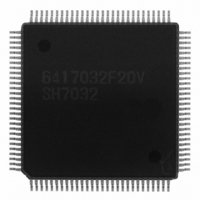HD6417032F20V Renesas Electronics America, HD6417032F20V Datasheet - Page 409

HD6417032F20V
Manufacturer Part Number
HD6417032F20V
Description
SH1 ROMLESS LEAD FREE
Manufacturer
Renesas Electronics America
Series
SuperH® SH7030r
Datasheet
1.HD6417034AFI20.pdf
(689 pages)
Specifications of HD6417032F20V
Core Processor
SH-1
Core Size
32-Bit
Speed
20MHz
Connectivity
EBI/EMI, SCI
Peripherals
DMA, POR, PWM, WDT
Number Of I /o
32
Program Memory Type
ROMless
Ram Size
4K x 8
Voltage - Supply (vcc/vdd)
4.5 V ~ 5.5 V
Data Converters
A/D 8x10b
Oscillator Type
Internal
Operating Temperature
-20°C ~ 75°C
Package / Case
112-QFP
Lead Free Status / RoHS Status
Lead free / RoHS Compliant
Eeprom Size
-
Program Memory Size
-
Available stocks
Company
Part Number
Manufacturer
Quantity
Price
Company:
Part Number:
HD6417032F20V
Manufacturer:
TI
Quantity:
201
- Current page: 409 of 689
- Download datasheet (5Mb)
When the SCI operates on an internal clock, it can output a clock signal at the SCK pin. The
frequency of this output clock is equal to the bit rate. The phase is aligned as in figure 13.3 so that
the rising edge of the clock occurs at the center of each transmit data bit.
Transmitting and Receiving Data (SCI initialization (Asynchronous Mode)): Before
transmitting or receiving, software must clear the TE and RE bits to 0 in the serial control register
(SCR), then initialize the SCI as follows.
When changing the communication mode or format, always clear the TE and RE bits to 0 before
following the procedure given below. Clearing TE to 0 sets TDRE to 1 and initializes the transmit
shift register (TSR). Clearing RE to 0, however, does not initialize the RDRF, PER, FER, and
ORER flags and receive data register (RDR), which retain their previous contents.
When an external clock is used, the clock should not be stopped during initialization or subsequent
operation. SCI operation becomes unreliable if the clock is stopped.
Figure 13.4 shows a sample flowchart for initializing the SCI. The procedure for initializing the
SCI is as follows:
1. Select the communication format in the serial mode register (SMR).
2. Write the value corresponding to the bit rate in the bit rate register (BRR) unless an external
3. Select the clock source in the serial control register (SCR). Leave RIE, TIE, TEIE, MPIE, TE,
4.
Figure 13.3 Phase Relationship Between Output Clock and Serial Data (Asynchronous
clock is used.
and RE cleared to 0. If clock output is selected in asynchronous mode, clock output starts
immediately after the setting is made in SCR.
Wait for at least the interval required to transmit or receive one bit, then set TE or RE in the
serial control register (SCR) to 1. Also set RIE, TIE, TEIE, and MPIE as necessary. Setting
TE or RE enables the SCI to use the TxD or RxD pin. The initial states are the mark transmit
state, and the idle receive state (waiting for a start bit).
0
D0
D1
D2
D3
1 frame
D4
D5
Mode)
Section 13 Serial Communication Interface (SCI)
D6
D7
Rev. 7.00 Jan 31, 2006 page 381 of 658
0/1
1
1
REJ09B0272-0700
Related parts for HD6417032F20V
Image
Part Number
Description
Manufacturer
Datasheet
Request
R

Part Number:
Description:
KIT STARTER FOR M16C/29
Manufacturer:
Renesas Electronics America
Datasheet:

Part Number:
Description:
KIT STARTER FOR R8C/2D
Manufacturer:
Renesas Electronics America
Datasheet:

Part Number:
Description:
R0K33062P STARTER KIT
Manufacturer:
Renesas Electronics America
Datasheet:

Part Number:
Description:
KIT STARTER FOR R8C/23 E8A
Manufacturer:
Renesas Electronics America
Datasheet:

Part Number:
Description:
KIT STARTER FOR R8C/25
Manufacturer:
Renesas Electronics America
Datasheet:

Part Number:
Description:
KIT STARTER H8S2456 SHARPE DSPLY
Manufacturer:
Renesas Electronics America
Datasheet:

Part Number:
Description:
KIT STARTER FOR R8C38C
Manufacturer:
Renesas Electronics America
Datasheet:

Part Number:
Description:
KIT STARTER FOR R8C35C
Manufacturer:
Renesas Electronics America
Datasheet:

Part Number:
Description:
KIT STARTER FOR R8CL3AC+LCD APPS
Manufacturer:
Renesas Electronics America
Datasheet:

Part Number:
Description:
KIT STARTER FOR RX610
Manufacturer:
Renesas Electronics America
Datasheet:

Part Number:
Description:
KIT STARTER FOR R32C/118
Manufacturer:
Renesas Electronics America
Datasheet:

Part Number:
Description:
KIT DEV RSK-R8C/26-29
Manufacturer:
Renesas Electronics America
Datasheet:

Part Number:
Description:
KIT STARTER FOR SH7124
Manufacturer:
Renesas Electronics America
Datasheet:

Part Number:
Description:
KIT STARTER FOR H8SX/1622
Manufacturer:
Renesas Electronics America
Datasheet:

Part Number:
Description:
KIT DEV FOR SH7203
Manufacturer:
Renesas Electronics America
Datasheet:











